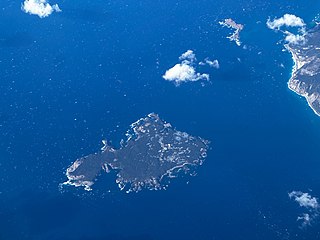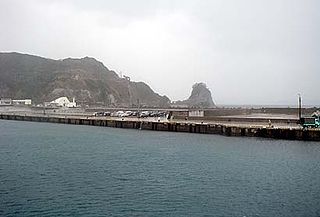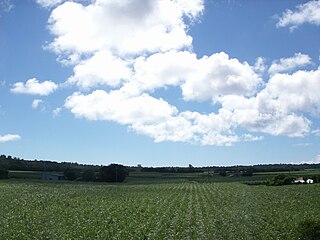
Motobu is a town located in Kunigami District, Okinawa Prefecture, Japan. As of October 2016, the town has an estimated population of 13,441 and a density of 250 persons per km2. The total area is 54.30 square kilometres (20.97 sq mi).

Kitadaitō is a village consisting of the islands of Kitadaitōjima and Okidaitōjima of Shimajiri District, Okinawa Prefecture, Japan.

Ogasawara is a village in Ogasawara Subprefecture, Tokyo Metropolis, Japan, that governs the Bonin Islands, Volcano Islands, and three remote islands.

The Izu Islands are a group of volcanic islands stretching south and east from the Izu Peninsula of Honshū, Japan. Administratively, they form two towns and six villages; all part of Tokyo Prefecture. The largest is Izu Ōshima, usually called simply Ōshima.

Tomari is a village located in Shiribeshi Subprefecture, Hokkaido, Japan. As of September 2016, the village had a population of 1,750, and a density of 21 persons per km2. The total area is 82.35 square kilometres (31.80 sq mi).

Haboro is a town located in Rumoi Subprefecture, Hokkaido, Japan.

Taketomi Island is an island in the town of Taketomi, within Yaeyama District of Okinawa Prefecture, Japan. Taketomi is one of the Yaeyama Islands. The population of Taketomi Island was 323 as of January 2012.

Shikine-jima (式根島) is a volcanic Japanese island in the Philippine Sea. The island is administered by Tōkyō and located approximately 160 kilometres (99 mi) south of Tōkyō and 36 kilometres (22 mi) south of Shimoda Shizuoka Prefecture. It is one of the Izu Seven Islands group of the seven northern islands of the Izu archipelago. The island is the smaller inhabited component of the village of Niijima, which also contains the larger, neighboring island of Niijima and the smaller, uninhabited Jinai-tō. It is part of the Ōshima Subprefecture of Tokyo Metropolis. As of 2009, the island's population was 600. Shikinejima is also within the boundaries of the Fuji-Hakone-Izu National Park.

Toshima is a village located in Ōshima Subprefecture, Tokyo Metropolis, Japan. The village comprises the whole of To-shima Island.

Hachijō Subprefecture is a subprefecture of Tokyo Metropolis, Japan. The organization of government belongs to the Tokyo Metropolitan Government Bureau Of General Affairs.

Aogashima (青ヶ島) is a volcanic island to the south of Japan in northernmost Micronesia. It is the southernmost and most isolated inhabited island of the Izu Islands. The islands border the northeast Philippine Sea and lie north of the Ogasawara Islands. The island lies approximately 358 kilometres (222 mi) south of mainland Tokyo and 64 kilometres (40 mi) south of Hachijō-jima.

Miyake is a village located in Miyake Subprefecture, Tokyo Metropolis, Japan. As of 1 October 2020, the village had an estimated population of 2,273, and a population density of 41.1 persons per km2. Its total area is 55.27 square kilometres (21.34 sq mi).

Hachijō is a town located in Hachijō Subprefecture, Tokyo Metropolis, Japan. As of 1 December 2022, the town had an estimated population of 7,056, and a population density of 97.7 persons per km2. Its total area is 72.24 square kilometres (27.89 sq mi). Electric power for the town is provided by a geothermal power station and by a wind farm.

Kōzushima Village is a village located in Ōshima Subprefecture, Tokyo Metropolis, Japan. As of 1 June 2022, the village had an estimated population of 1,841, and a population density of 99 persons per km2. Its total area is 18.58 square kilometres (7.17 sq mi).

Ōshima is a town located in Ōshima Subprefecture, Tokyo Metropolis, Japan. As of 1 October 2020, the town had an estimated population of 7,102, and a population density of 78.3 persons per km2. Its total area is 90.76 square kilometres (35.04 sq mi).

Mikurajima Village is a village located in Miyake Subprefecture, Tokyo Metropolis, Japan. As of 1 October 2020, the village had an estimated population of 323, and a population density of 11.7 persons per km2. Its total area is 20.54 square kilometres (7.93 sq mi).

Niijima is a village located in Ōshima Subprefecture, Tokyo Metropolis, Japan. As of 1 October 2020, the village had an estimated population of 2,441, and a population density of 88.6 persons per km2. Its total area is 27.54 square kilometres (10.63 sq mi).

Hachijō-kojima (八丈小島) is a small volcanic deserted island in the Philippine Sea approximately 287 kilometres (178 mi) south of Tokyo, and 7.5 kilometres (4.7 mi) west of Hachijō-jima, in the northern Izu archipelago, Japan. Administratively the island is within Hachijō, Tokyo, Japan.

Tonaki is a village located in Shimajiri District, Okinawa Prefecture, Japan. The village consists of Tonaki Island and the uninhabited Irisuna Island.

Minamidaitō is a village located entirely on Minamidaitōjima in Shimajiri District, Okinawa Prefecture, Japan. Minamidaitōjima is located approximately 360 kilometres (220 mi) east of Okinawa Island. Minamidaitō covers 30.7 square kilometres (11.9 sq mi).


























